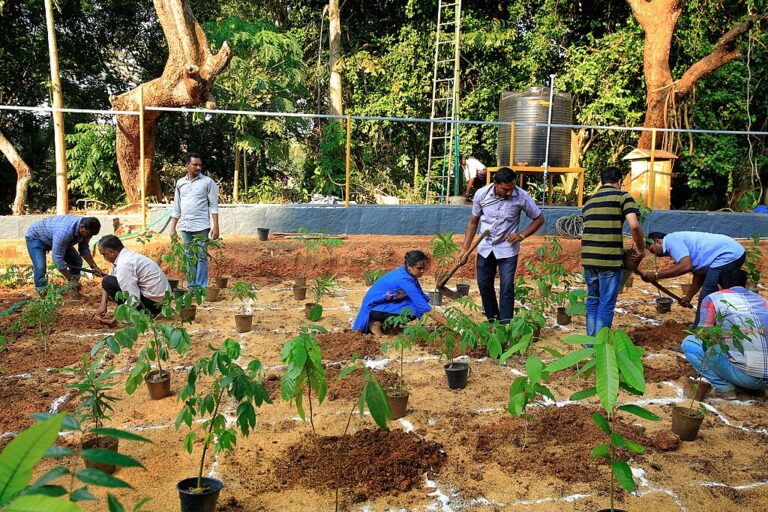- So far, 121 wildlife corridors have been identified across Chhattisgarh by the state forest department, for the Strategic Plan for Conservation of Corridors. Out of these, 14 have been selected as critical ones which need special attention.
- The state has several fractured forest areas due to the impact of mining and road development projects. Under the corridor restoration plan, the aim is to connect isolated forest patches, territorial forests and wildlife sanctuaries to ensure continuity.
- Experts point out that viable populations, especially of wide-ranging species, can be sustained if corridors that maintain connectivity between protected areas are conserved.
A strategic plan for conservation, monitoring and management of wildlife corridors has been prepared by the Chhattisgarh forest department. As part of this exercise under the CAMPA (Compensatory Afforestation Fund Management and Planning Authority), identification of various potential corridors in the state is being undertaken. The target species include two long-ranging animals, tigers and elephants, which frequently use corridors for dispersal, as well as their prey base. Other important species include leopard, sloth bear and the wild buffalo.
So far, 121 corridors have been identified across the state, for the Strategic Plan for Conservation of Corridors, by the state forest department. Out of these, 14 wildlife corridors have been selected as critical ones which need special attention, more resource allocation, specific policies, awareness generation and crisis management plan.
This exercise is separate from Wildlife Institute of India’s (WII) efforts to develop wildlife corridors. Chhattisgarh additional principal chief conservator of forests and chief executive officer of CAMPA, Sreenivasa Rao, told Mongabay-India that the Dehradun-based WII had initiated a plan to develop corridors long ago, but somehow a clear management and conservation plan was lacking. Also, the institute had restricted its work to only corridors connecting tiger reserves in India.
“What Chhattisgarh is at present undertaking is a first of its kind in the country. There are many fractured forest areas in the state. This is happening due to mining and road development projects bifurcating forests. Under this plan, there is an intention to connect isolated forest patches, territorial forests and wildlife sanctuaries to ensure continuity. As CAMPA allows work for corridor restoration as one of its mandates, corridor revival has been included in the annual plan of operation of 2020-21. At present, ground proofing work is on,” he said.

Rao added that Shivaji Chavan, the director of Mumbai-based non-profit Wildlife and We Protection Foundation has helped the state forest department to prepare the detailed project report.
One of the most important corridors in Chhattisgarh is the Kanha-Achanakmar corridor. “We want development but at the same time have to preserve the genetic pool as well. Currently, corridors are restricted from one tiger reserve to another. Across the state, the forest department wants to link all kinds of corridors for wildlife. If the Government of India permits in future, we would also want to work on inter-state corridors as we have elephants coming here from Odisha and Jharkhand. Right now work on only intra-state corridors will be on.”
The first priority will be to establish the link between the Achanakmar tiger reserve in Mungeli district and the Bhoramdeo Wildlife Sanctuary in Kabirdham district. The budget for this is roughly Rs. 20 crores (Rs. 200 million).
Next would be the natural corridor between Kanha tiger reserve located in Madhya Pradesh and Bhoramdeo in Chhattisgarh. The total budget for the restoration of the corridors is being finalised.
Preparing the ground
The field orientation and training programmes for the corridor project in Chhattisgarh have been in Bilaspur, Surguja, Raipur and Durg forest circles, and the Kanha-Achanakmar Tiger Reserve Wildlife Corridor so far.
Bilaspur divisional forest officer Kumar Nishant informed that training workshops for forest department officials were mainly organised in January-February across the state. In Bilaspur district, the Kota area has been studied due to the presence of a corridor.
“The government wants the corridors to go back to their original state. Corridors have been classified under high-priority areas, medium ones and low-priority priority areas. As part of the field exercise, we have collected sufficient data, especially in high-priority areas. There is also a need to study the prey base, whether power transmission lines are crossing through a particular area, the presence of water sources and so on. There is disturbance in many corridors due to railway tracks and human encroachment. Through agro-forestry in forest fringe areas, the forest department will try to reduce dependency of local communities on forests. If we create dabris (farm ponds) in villages, people can practise fisheries too in them,” Nishant said.

Chavan of Wildlife and We informed Mongabay-India that fragmentation has led them to rethink the importance of corridors. Genetic exchange between dispersing animals has to be ensured to prevent inbreeding. At the same time, development is also important as human population is also rising.
“We are trying to protect the Kanha-Achanakmar corridor. Corridors are like rivers and they pass through different habitations. Due to fragmentation, some protected areas have become islands. So, there should be connectivity in between two areas for animals to pass through easily. If one corridor is destroyed, several adjoining areas get damaged. Corridors take years to form,” Chavan said.
He added that landscapes are fragmented because of the presence of human habitations. Corridors already identified lie between tiger reserves but other such connectivities are also important. “We have to empower communities so that they can protect the corridors. We will also identify more corridors and map them. As we will never have enough funds to address all corridors, let us give priority and then categorise them. These corridors and connectivities take ages to form and we cannot lose them,” Chavan added. It has been found that certain corridors are important due to their location but somehow they have not been prioritised, the expert informed.
Why are corridors important?
Prachi Thatte, coordinator, connectivity conservation, WWF India, said, viable populations, especially of wide-ranging species, can only be sustained if corridors that maintain connectivity between protected areas are conserved. “Connectivity is essential for natural ranging behaviour of animals, for example, for movement among foraging sites or dispersal of animals from their natal sites. Lack of corridors would restrict dispersal and genetic exchange between protected areas, reducing genetic diversity and increasing the risk of extinction of species,” she said.
Commenting on the focus on tiger corridors, she added that this is due to a global bias. Corridor research and conservation across the globe is largely focused on large predators, she pointed out. “In India, significant attention and resources are invested in the recovery and conservation of the tiger, and hence there is likely more emphasis on tiger corridors. A lot of work is being done on elephant corridors too. While it is good that there is emphasis on the conservation of corridors of these two species, conservation strategies based on information from a single species may not always effectively capture varied ecological requirements for dispersal of other species. So, corridor conservation and management should ideally factor in the different requirements of multiple species,” Thatte added.

Former WII director Vishwas Sawarkar said the tiger is an iconic species. Though there is no specific emphasis on the term ‘tiger corridor’, the species occurs in 18 states/union territories in the country, and hence, there is a practice of adding tiger to the ecological connectivity called a corridor or a dispersal corridor. “Tigers are secretive in their behavior and therefore need safe passage during dispersal. But all animals need safe passages,” he added.
According to Sawarkar, Chhattisgarh has established the scientific basis for identifying corridors. “Setting up core areas helps in providing greater focus of protection and management. The methodology provides excellent understanding of how corridors need to be scientifically designed. It is a template for the future. If managed as per the plan there will be a new chapter in the conservation of meta-populations — populations that appear geographically separated but can be connected via corridors to allow interactions, movement and breeding. There is an obvious benefit for other states. They would have a readymade scientific approach for the identification of natural connectivity between large habitats and a scientific design for their management and monitoring.”
Banner image: In total, 121 wildlife corridors have been identified across Chhattisgarh for the Strategic Plan for Conservation of Corridors. It is the first state to identify corridors for all kinds of wildlife. Photo from Chhattisgarh Forest department.













